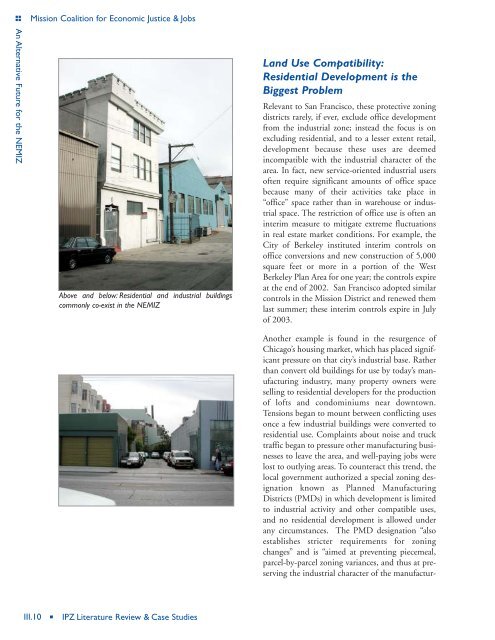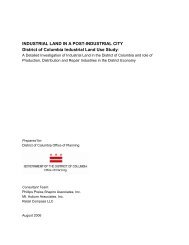An Alternative Future for the North East Mission Industrial Zone
An Alternative Future for the North East Mission Industrial Zone
An Alternative Future for the North East Mission Industrial Zone
Create successful ePaper yourself
Turn your PDF publications into a flip-book with our unique Google optimized e-Paper software.
<strong>An</strong> <strong>Alternative</strong> <strong>Future</strong> <strong>for</strong> <strong>the</strong> NEMIZ<br />
<strong>Mission</strong> Coalition <strong>for</strong> Economic Justice & Jobs<br />
Above and below: Residential and industrial buildings<br />
commonly co-exist in <strong>the</strong> NEMIZ<br />
III.10 IPZ Literature Review & Case Studies<br />
Land Use Compatibility:<br />
Residential Development is <strong>the</strong><br />
Biggest Problem<br />
Relevant to San Francisco, <strong>the</strong>se protective zoning<br />
districts rarely, if ever, exclude office development<br />
from <strong>the</strong> industrial zone; instead <strong>the</strong> focus is on<br />
excluding residential, and to a lesser extent retail,<br />
development because <strong>the</strong>se uses are deemed<br />
incompatible with <strong>the</strong> industrial character of <strong>the</strong><br />
area. In fact, new service-oriented industrial users<br />
often require significant amounts of office space<br />
because many of <strong>the</strong>ir activities take place in<br />
“office” space ra<strong>the</strong>r than in warehouse or industrial<br />
space. The restriction of office use is often an<br />
interim measure to mitigate extreme fluctuations<br />
in real estate market conditions. For example, <strong>the</strong><br />
City of Berkeley instituted interim controls on<br />
office conversions and new construction of 5,000<br />
square feet or more in a portion of <strong>the</strong> West<br />
Berkeley Plan Area <strong>for</strong> one year; <strong>the</strong> controls expire<br />
at <strong>the</strong> end of 2002. San Francisco adopted similar<br />
controls in <strong>the</strong> <strong>Mission</strong> District and renewed <strong>the</strong>m<br />
last summer; <strong>the</strong>se interim controls expire in July<br />
of 2003.<br />
<strong>An</strong>o<strong>the</strong>r example is found in <strong>the</strong> resurgence of<br />
Chicago’s housing market, which has placed significant<br />
pressure on that city’s industrial base. Ra<strong>the</strong>r<br />
than convert old buildings <strong>for</strong> use by today’s manufacturing<br />
industry, many property owners were<br />
selling to residential developers <strong>for</strong> <strong>the</strong> production<br />
of lofts and condominiums near downtown.<br />
Tensions began to mount between conflicting uses<br />
once a few industrial buildings were converted to<br />
residential use. Complaints about noise and truck<br />
traffic began to pressure o<strong>the</strong>r manufacturing businesses<br />
to leave <strong>the</strong> area, and well-paying jobs were<br />
lost to outlying areas. To counteract this trend, <strong>the</strong><br />
local government authorized a special zoning designation<br />
known as Planned Manufacturing<br />
Districts (PMDs) in which development is limited<br />
to industrial activity and o<strong>the</strong>r compatible uses,<br />
and no residential development is allowed under<br />
any circumstances. The PMD designation “also<br />
establishes stricter requirements <strong>for</strong> zoning<br />
changes” and is “aimed at preventing piecemeal,<br />
parcel-by-parcel zoning variances, and thus at preserving<br />
<strong>the</strong> industrial character of <strong>the</strong> manufactur-












